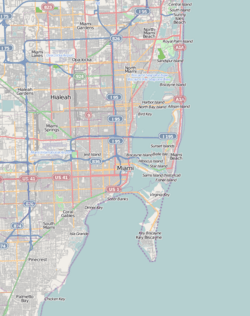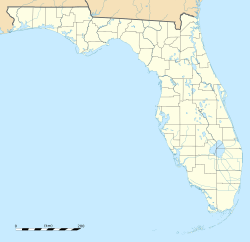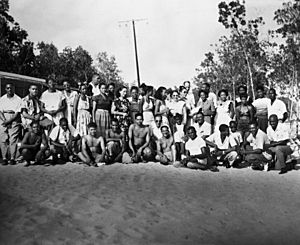Virginia Key facts for kids
Quick facts for kids
Virginia Key
|
|
|---|---|
|
Neighborhood of Miami
|
|
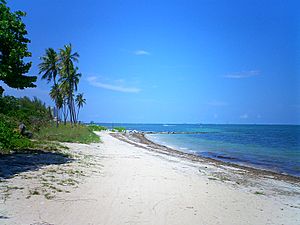
Virginia Key Beach
|
|
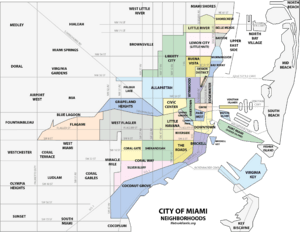
Virginia Key in Miami
|
|
| Country | United States |
| State | Florida |
| County | Miami-Dade County |
| City | Miami |
| Area | |
| • Total | 1.35 sq mi (3.5 km2) |
| Time zone | UTC-05 (EST) |
| ZIP Code |
33149
|
| Area code(s) | 305, 786 |
| Virginia Key | |
|---|---|
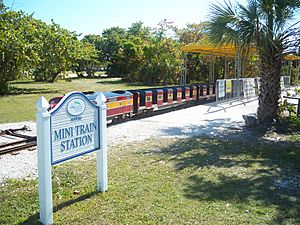
Virginia Key railroad at the park
|
|
| Type | Municipal |
| Location | Virginia Key, Miami, Florida, United States |
| Area | 863 acres (3.49 km2) |
| Created | 1945 |
| Operated by | City of Miami |
| Website | Virginia Key Beach Park |
|
Virginia Key Beach Park
|
|
| Location | Virginia Key, Miami |
| Built | 1945 |
| Architectural style | Masonry |
| NRHP reference No. | 02000681 |
| Added to NRHP | June 28, 2002 |
Virginia Key is a cool island in Miami, Florida, United States. It's a barrier island, meaning it protects the mainland from ocean waves. The island is about 863 acres (3.5 km2) big. You can find it in Biscayne Bay, just south of Brickell and north of Key Biscayne. To get there from the mainland, you cross the Rickenbacker Causeway.
Virginia Key is home to many interesting places. These include the Virginia Key Beach Park, the Miami Seaquarium, and the University of Miami's Rosenstiel School of Marine and Atmospheric Science. You can also find the former Miami Marine Stadium and offices for the U.S. National Oceanic and Atmospheric Administration.
Contents
History of Virginia Key
Virginia Key used to be part of a much longer island. This island stretched from Fort Lauderdale all the way down to Key Biscayne. Over time, storms and hurricanes changed the coastline. In the 1830s, big storms created a new opening called Norris Cut. This cut separated Virginia Key from what is now Fisher Island near Miami Beach.
In 1849, a man named Frederick H. Gerdes named the island "Virginia Key." He noted that it had a nice Atlantic beach. However, much of the island was covered in mangrove trees. Fun fact: some scenes from the 1994 movie Ace Ventura: Pet Detective were filmed here!
Virginia Key Beach Park's Story
In May 1945, a group of seven civil rights activists made history. They protested unfair laws by going to a "whites-only" beach in Florida. These laws, called Jim Crow laws, stopped Black people from using many public places. This included the beautiful beaches of Miami.
The fight for a "colored-only" beach was a big step. It showed the start of the civil rights movement. Black soldiers who fought in World War II were especially upset. They had fought against racism abroad, only to return to a segregated America. One of the protesters was Attorney Lawson B. Thomas. He later became the first Black judge in the South after the Civil War.
The NAACP, a civil rights group, told the police and news about the protest. They hoped for arrests to challenge the unfair laws in court. But the police did not arrest anyone. Instead, they told the protesters to talk to County Commissioner Charles H. Crandon.
Local leaders knew they had to do something. Miami's economy depended on tourism. They decided to create a "colored-only" beach on Virginia Key. This beach opened on August 1, 1945. It was called "Virginia Key Beach, a Dade County Park for the exclusive use of Negroes." Today, it's known as the Historic Virginia Key Beach Park.
For a while, Black people could only reach the beach by boat. But in 1947, the Rickenbacker Causeway opened. This connected Virginia Key to the mainland, making it easy to drive there. The new park became very popular right away.
The park had fun attractions like a miniature railroad and a merry-go-round. However, it was much smaller than the "whites-only" Crandon Park. Over time, things changed. Crandon Park got a zoo, but Virginia Key Beach got a pond. Also, garbage and sewage from Key Biscayne were dumped nearby. This made the beach smell bad and the water dirty. Even so, Virginia Key Beach remained a special place for Miami's Black community.
Park Restoration and Reopening
Segregation on Miami-Dade beaches finally ended in the early 1960s. This happened after more protests led by people like Rev. Theodore Gibson. After this, all beaches were open to everyone. Because other beaches were now open, Virginia Key Beach became less used. It also wasn't kept up very well. In 1982, the city closed the park because it cost too much to maintain.
The park was closed for 20 years. Storms damaged it, buildings were vandalized, and unwanted plants grew everywhere. Some city officials thought about selling parts of the island for development. But local groups fought against this. They wanted the park to be restored and reopened. A special task force was created to plan the park's future.
This task force became a trust. Their job was to reopen the park as a green space for everyone. They worked to remove unwanted plants and bring back native ones. In August 2002, the park was added to the National Register of Historic Places. This means it's a very important historical site.
On February 22, 2008, the Virginia Key Beach Park Trust reopened the park. Today, it's known as an amazing natural area. It has the largest mangrove wetland in Florida. Old buildings like the bathhouse and concession stand have been fixed up. The beach is open for wading, and everyone can enjoy this historic place.
Cool Features of Virginia Key
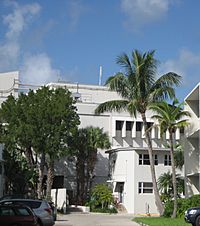
- Oceanic and Atmospheric Research: The Atlantic Oceanographic and Meteorological Laboratory (AOML) is located here. It's part of NOAA, a U.S. government agency. Scientists at AOML study the ocean and atmosphere. They want to understand how they work and how they affect each other.
- Hobie Beach: Along the causeway to Virginia Key, there's a popular spot called Hobie Beach. It's great for windsurfers and sailors. It's also the only beach in the Miami area where dogs are allowed! It's a perfect place for a picnic with a view.
- Miami Seaquarium: The Miami Seaquarium is a marine park on Virginia Key. It opened in 1955 and has many marine animals. You can see orcas, dolphins, sea lions, manatees, and sharks. They also have daily shows with marine mammals.
- Rosenstiel School: The Rosenstiel School of Marine and Atmospheric Science is part of the University of Miami. It's a special school for studying the ocean and atmosphere. It's the only tropical research institute of its kind in the United States. Many scientists and students work here to learn about our planet.
- MAST Academy: The Maritime and Science Technology (MAST) Academy is a public high school on Virginia Key. Students who love science and technology can attend this special school.
- Mountain Biking Park: If you like biking, Virginia Key has a mountain biking park. It was built by the Virginia Key Bicycle Club. The park has trails for beginners, intermediate riders, and advanced bikers.
Education on Virginia Key
Students living on Virginia Key are part of Miami-Dade County Public Schools. Younger students (K-8) go to the Key Biscayne K-8 Center. For middle school, students can also choose to go to Ponce de Leon Middle School in Coral Gables. High school students attend Coral Gables High School.
As mentioned, the magnet school MAST Academy is also located on Virginia Key.
See also
 In Spanish: Virginia Key para niños
In Spanish: Virginia Key para niños


